30-amp RVs are the most common rigs on the road. As a result, 30-amp RV plugs and outlets are also very common.
The ability to utilize a 30-amp outlet, even if you have a 15- or 50-amp RV, allows you to take advantage of that power regardless of your own rig’s plug.
That’s why we’re here to offer the complete guide to the 30-amp RV plug.
Whether you have a 15-amp, 30-amp, or 50-amp RV, this information is important to know, so let’s get right to it!
- 1) How Do I Know the Amp Rating of my RV?
- 2) What’s the Difference Between 30-amp and 50-amp Power?
- 3) If I Have a 30-amp RV Can I Plug Into a 15-amp or 50-amp Outlet?
- 4) BUT…. and this is important…
- 5) The Importance of Heavy-Duty Outdoor Extension Cords
- 6) How Can I Protect My 30A RV from Power Surges?
- 7) How to Replace a 30-amp Plug on Your RV’s Power Cord
- 8) Can You Plug an RV Into a 30-amp Dryer Outlet?
- 9) Can I Install a 30A RV Outlet at Home?
- 10) Free RVing Tips, Tricks, Reviews, Giveaways & More
How Do I Know the Amp Rating of my RV?
First things first! Before figuring out how to best use a 30 amp power outlet, you need to know the amp rating of your own RV. We know this may sound basic, but even some people who’ve been RVing for a while may not have thought about the specs of their own rig.
The quickest way to obtain this information (even easier than finding your owner’s manual.. and certainly easier than calling customer service at your RV dealer!) is to look at your RV’s power plug. The design of the plug will tell you what amp RV you own.
Let’s take a quick look at three photos.
Note… our apologies to all of our friends RVing around the world in countries with 220/240-volt systems. This particular topic is primarily specific to North America. We’ve used your systems on FIVE international RV trips and love them!
15-amp Standard Household Plug
Most household electrical outlets in North America are designed for 15-amp plugs. Items like lamps and other low-power-draw appliances generally have a 15-amp plug with two prongs that look like this:
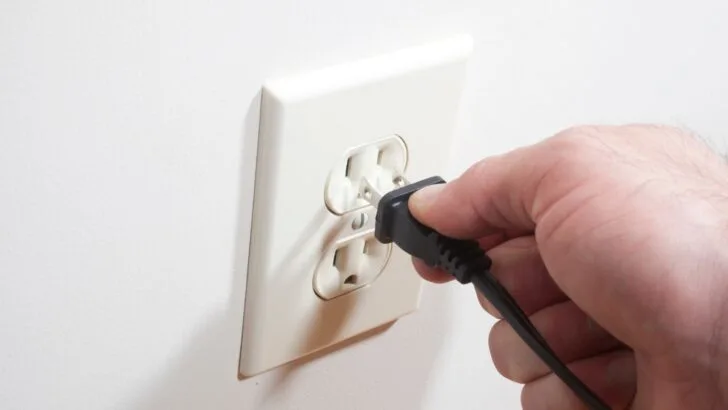
This is a standard 15-amp household electrical outlet. Even though it’s a grounded outlet, ready to accept a three-pronged grounded plug, it can also accept a two-pronged plug, like this one.
Grounded 15-amp plugs have a third prong. Standard 15-amp household outlets are designed to accept this type of plug. But even with the addition of that third (ground) prong, this is still a 15-amp plug.
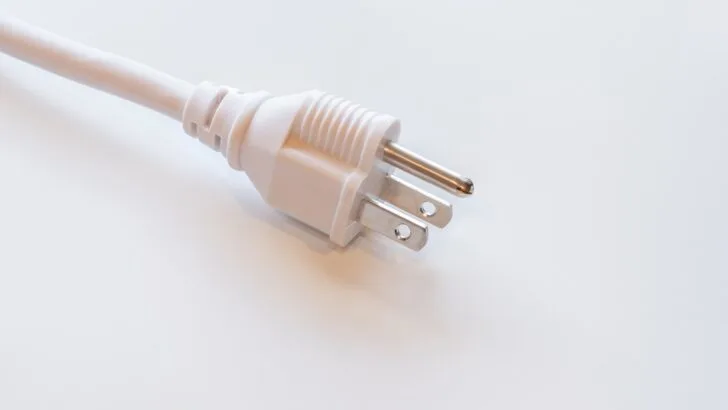
The third prong on this 15-amp plug indicates that it’s a grounded plug. But it’s still 15-amps.
We should probably mention that 20-amp outlets are generally used in places where more power might be needed. (Think larger appliances or power tools like refrigerators, food processors, and electric lawnmowers or hedge trimmers.) This is why 20-amp outlets are more often found in kitchens and garages. Note that “larger appliances” does not include washers and dryers, which require even more power.
The presence of a 20-amp outlet indicates that the circuit breaker feeding it is also rated to handle 20-amps. This is a great choice to plug your RV into when “moochdocking” in a friend’s driveway! (Again, look in the garage.)
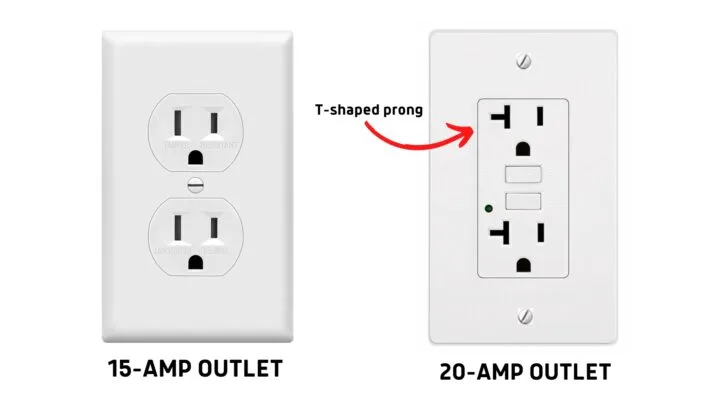
You can distinguish a regular grounded 15-amp outlet from a 20-amp outlet by the T-shaped prongs found on 20-amp outlets. We look for a 20-amp outlet to plug our rig into when “moochdocking” with family and friends!
If you look at your RV’s power cord and see a plug with three larger prongs, spaced further apart with two of them at an angle, then your RV has 30-amp service. This plug would go into the 30 amp outlet at an RV park or campground.
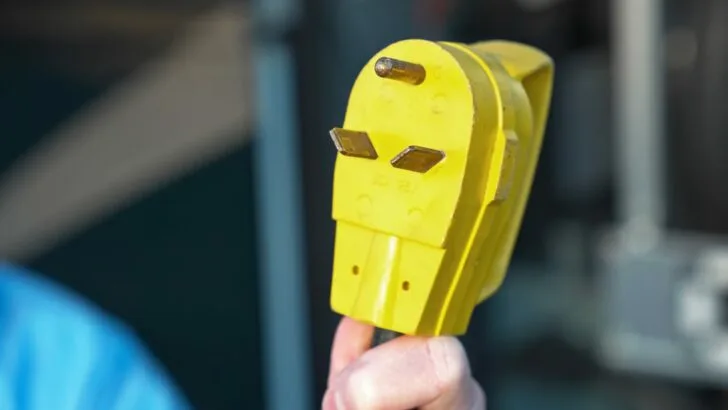
A 30-amp RV plug like this one fits into a 30-amp receptacle at an RV park.
And finally, large RVs such as Class A motorhomes, large 5th wheels, and other big rigs offer 50-amp service. That’s what your RV has if your rig’s power plug has 4 prongs like this one:
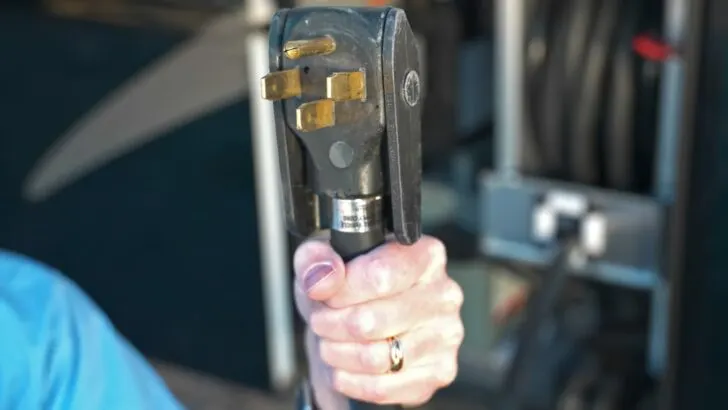
The four prongs on this RV plug indicate that this is a 50-amp RV plug. This is most common on the largest RVs.
Here’s a good representation of what the various outlets look like for 15/20-amp, 30-amp, and 50-amp services:
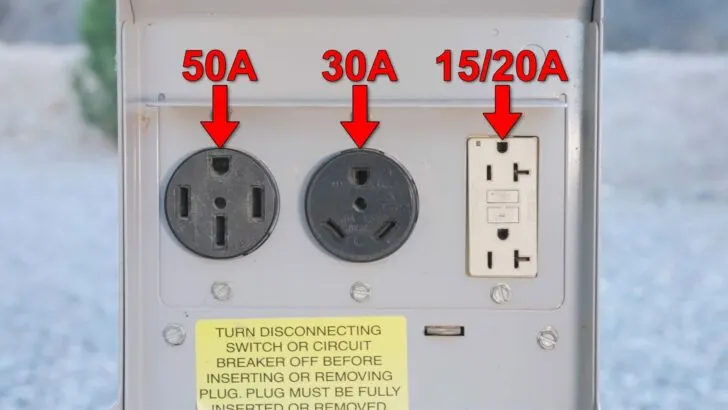
This campground pedestal offers all three types of service. From left to right — 50-amp, 30-amp and 15/20-amp.
Another easy way to surmise the power rating of an RV is to look at the roof. If it has no air conditioner units at all (think pop-up trailer), it may only be equipped with 15-amp service. If there’s a single A/C unit, it likely has 30-amp service. 2 or 3 A/C units or more (yes, they’re out there!) is a certain indication of a 50-amp RV.
In general, the larger the RV, the more electrical equipment it has, so the larger the power needs.
What’s the Difference Between 30-amp and 50-amp Power?
The 30-amp power plug has three prongs. Each corresponds to one of three wires: hot, neutral, and ground.
A 30-amp connection provides 3,600 watts of power (30A x 120V).
As shown in the photo above, a 50-amp RV plug has four prongs. Those provide two 120V legs of 50 amps each, one shared neutral wire, and one ground wire. Yes, that actually equals 100 amps (50 on each leg).
If you saw our post on the 50-amp RV plug, you may recall that a 50-amp connection provides significantly more power than just the difference between 50 amps and 30 amps. That’s largely due to the two 50-amp hot leads on a 50-amp plug vs. the single 30-amp hot lead coming into a 30-amp plug.
A 50-amp connection provides 12,000 Watts (50A x 120V = 6,000W x 2 = 12,000W).
So, the difference between 30-amp power and 50-amp power is technically 8,400 Watts (12,000W – 3,600 W).
If I Have a 30-amp RV Can I Plug Into a 15-amp or 50-amp Outlet?
Yes indeed! If your RV has 30-amp service, you can plug into a 15/20-amp or 50-amp power outlet if there’s no 30-amp RV outlet available. However, you’ll need to have some dog bone adapters.
Let’s take a look at the details!
Plugging a 30-amp RV into a 15/20-amp household outlet requires a 30-to-15-amp “dogbone” adapter (often referred to as “dog-boning down” to 15-amps).
To plug a 30-amp RV into a 50-amp (4-prong) outlet you’ll need a 30-to-50-amp dogbone. This is sometimes referred to as “dog-boning up” to 50-amps.
In fact, we keep dog bone adapters in our toolkit of RV electrical supplies and use them all the time. (Our Class A motorhome has 50-amp service, so we only need to dogbone down.)
For an RV with 30-amp service, here are the adapters you’ll need to carry.
30-amp to 15-amp Dogbone Adapter
If your RV has 30-amp service and you need to plug into a 15-amp outlet, you’ll need a 30-amp female to 15-amp male adapter.
This will allow you to connect your RV to a 15-amp power outlet.
- Adapter Connection: Designed to connect to a standard residential outlet and adapts the connection to fit your 30-amp RV
- Contoured Design: Allows for easy removal from the outlet
30-amp to 50-amp Dogbone Adapter
If your RV has 30-amp service and you need to plug into a 50-amp outlet, you’ll need a 30-amp female to 50-amp male adapter.
This adapter will allow you to plug your 30-amp RV into a 50-amp power outlet.
- Converts Electrical Connection Type: Designed to allow you to hookup to your campground's power pedestal, adapting the electrical connection to fit...
- High Conductivity: Heavy-duty 50-amp male (NEMA 14-50P) and 30-amp female (NEMA TT-30R) electrical heads. Rated for 125 volts/3750 watts. Constructed...
For RVs with other amp ratings (smaller 15-amp rigs, and larger 50-amp rigs) here’s a summary of which dogbone adapters you’ll want to carry on board:
15-amp to 30-amp Adapter
If you have a 15-amp RV, and you want to plug into a 30-amp outlet, you can use a 15-amp female to 30-amp male dog bone adapter to plug into a 30-amp service.
You can plug into a 30-amp power outlet using an adapter like this one:
- RV Dogbone Electrical Adapter, Safely converts power for use at recreational areas, motor parks, and campgrounds
- 30 AMP Male (TT-30P) to 15 AMP Female Standard Home style Cord
50-amp to 30-amp Adapter
And finally, if you have a 50-amp RV and need to plug into a 30-amp outlet, you can use a 50-amp female to 30-amp male dog bone adapter like this one:
- Converts Electrical Connection Type: Designed to allow you to hookup to your campground's power pedestal, adapting the electrical connection to fit...
- High Conductivity: Heavy-duty 30-amp male (NEMA TT-30P) and 50-amp female (NEMA 14-50R) electrical heads. Rated for 125 volts/3750 watts. Constructed...
If you want to plug your 50-amp rig into a 15-amp or 15/20-amp outlet, you’ll need to use TWO dogbones. You’ll plug your rig into your 50-to-30-amp adapter and then plug that into a 30-to-15-amp adapter. Note that this is the exact same one owners of 30-amp rigs carry, which we’ve listed above.
Again, we dogbone our 50-amp rig all the way down to 15-amps (again, using two adapters) whenever we’re visiting family or friends and want to trickle charge our batteries using an outlet in their garage.
BUT…. and this is important…
When dog-boning down to a lower amp rating (plugging your 50-amp RV into 30- or 15-amps, or your 30-amp RV into 15-amps), keep this one thing in mind: You won’t be able to use all of the appliances you are accustomed to running when you’re connected to the service your RV plug was meant to handle.
Pay attention to the limits of the lower amp rating you’re connected to, and moderate your power demands accordingly. You’ll know you’ve neglected to do this when you trip the circuit breaker on the pedestal (or in your cousin’s garage). Reduce your power demand before that happens!
For a complete visual guide to dog bone adapters, check out our video “Dog Bones 101”:
The Importance of Heavy-Duty Outdoor Extension Cords
When you’re too far from the power source, it’s important to have a heavy-duty outdoor extension cord for use with your RV.
If you’ve got an RV with 30-amp electric service, you’ll want a good quality, heavy-duty outdoor 30A extension cord. (Likewise, if you have a 50-amp RV, you’ll want a 50A heavy-duty extension cord.)
The same is true if your RV has a 15-amp power cord. You’ll need a good, heavy-duty outdoor 15-amp extension cord.
You’ll want to use the heaviest-duty cord possible to avoid the risk of overheating. The longer the extension cord, the greater the risk of overheating and the heavier the cord needs to be.
Also, drawing too much current through an under-rated extension cord could lead to an electrical fire.
For an RV with 30A service, a high-quality, heavy-duty outdoor extension cord like this one is a good choice:
- EXTENDED LENGTH: 30 amp extension cord extends 50-feet long, providing the necessary length to power your RV.
- HIGH CONDUCTIVITY: Features a standard 30-amp male (NEMA TT-30P) and 30-amp female (NEMA TT-30R) connectors. Rated for 125 volts/3750 watts....
How Can I Protect My 30A RV from Power Surges?
How do you know if a power pedestal is wired properly at any given campsite? Also, how do you know its condition before plugging your valuable RV into it?
It’s possible for your RV’s electrical system to be seriously damaged by a power surge or miswired pedestal anywhere you plug into a power source.
A high-quality surge protector is a relatively pricey investment, but it’s nowhere near as pricey an investment as your RV is!
We recommend a high-quality surge protector like the Power Watchdog from Hughes Autoformers, which is the one we use ourselves (and absolutely love)! We’ve even been able to arrange a special discount for RVgeeks readers. Just use promo code RVGEEKS at checkout.
Make sure your RV is protected from low voltage, bad RV park wiring AND power surges when connecting to shore power with a Power Watchdog and/or Hughes Autoformer. We never hookup without ours (we...Show More
Make sure your RV is protected from low voltage, bad RV park wiring AND power surges when connecting to shore power with a Power Watchdog and/or Hughes Autoformer. We never hookup without ours (we have both), and know our RV's electrical system and all our electronics are being protected.
Watch our Hughes Autoformer video
Watch our Hughes Power Watchdog video
Save 10% on your entire purchase when ordering from Hughes!
Show LessPrices vary, so check current Amazon pricing, too:
- Replaceable Surge / Spike Module: Should a large spike happen, surge module is completely replacable instead of replacing the entire unit.
- Wirelessly Monitor voltage, amperage, and wattage on your smartphone in real time using our free mobile app! Oldest and most reliable phone app in the...
- Replaceable Surge / Spike Module: Should a large spike happen, surge module is completely replacable instead of replacing the entire unit.
- Wirelessly Monitor voltage, amperage, and wattage on your smartphone in real time using our free mobile app! Oldest and most reliable phone app in the...
The Power Watchdog offers more features and higher surge protection than competitive units — and at a lower price. It will protect your RV in a variety of important ways, which we detail in this video:
How to Replace a 30-amp Plug on Your RV’s Power Cord
If you need to replace the 30 amp plug on your RV’s power cord, it’s a pretty straightforward job for a competent DIY RVer.
The new plug is likely to come with instructions, but in general, these are the steps to replace it:
- Cut off the old plug.
- Trim back the insulation on the cord.
- Strip the wires.
- Attach the wires to the correct terminals in the replacement plug.
If you don’t already have one, we like this self-adjusting wire stripper and use ours all the time.
- SELF-ADJUSTING: Strip wire from 10 to 24 AWG with our self-adjusting mechanism. Jaw Width: 2 inches
- ADJUSTABLE STOPPER: Control the length of the core strip with the built-in adjustable stopper
Can You Plug an RV Into a 30-amp Dryer Outlet?
This is a tricky question. So tricky, as a matter of fact, that we personally would NEVER plug a 30A RV into a clothes dryer power outlet.
That’s because there are several different types of dryer outlets, some of which are 100% incompatible with RVs. Since it takes an expert to truly understand when it’s safe and when it’s not, we’re going with NO! Don’t plug your 30-amp RV into a dryer outlet!
All of that said… there are circumstances where it’s OK, so if you’re REALLY interested in knowing the details read this: Can I Plug My RV Into My Dryer Outlet? RV -vs- Dryer Outlet!
Can I Install a 30A RV Outlet at Home?
If you’ve got a 30A RV and want a (safe!) 30A power outlet to plug into at home, it can be done if you’re confident & competent working with electricity.
You could also have a 30A outlet professionally installed at home. Just make sure the electrician knows you want an outlet to use with an RV and not as a dryer outlet!
Take a look at this video showing the steps to installing a 30-amp RV outlet to decide whether this is a DIY project that you’d be comfortable undertaking or whether it would be better to call in a pro.
Free RVing Tips, Tricks, Reviews, Giveaways & More
Subscribe to our daily newsletter! We’ve been full-time RVers for 20 years (!) and share everything we’ve learned about RVing in our daily blog posts. Join our online community to receive a wealth of great RVing knowledge delivered right to your inbox.
Whether this is your first time on the road or you’re a seasoned full-timer, you’ll love the wide range of RVing topics we cover. Don’t miss a single article or any of our famous RV gear Giveaways — Subscribe today!








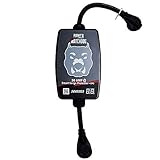


Dave Edler
Sunday 21st of January 2024
If we have 30 amp rv an have the chance to plug into a 50 amp at the camp ground ,with the proper dog bone. Do we gain anything??? Sometimes if the AC is on a the microwave an a fan we have, the main breaker will trip…. Thanks, Have learned a lot from you guys 🤠🤠🤠
TheRVgeeks
Monday 22nd of January 2024
Good question, Dave. For all intents and purposes, no. There's not really any benefit to dogboning a 30-amp RV up to a 50-amp connection... other than getting to connect to power if there's no other option at the pedestal. You won't be able to draw any more power than 30-amps total... if you do, your main 30-amp breaker in your RV's breaker box will trip. Plus, you're technically losing the protection the pedestal breaker provides to your power cord. IF you had a situation where your RV's breaker didn't trip and too much power was being drawn, your power cord could melt and/or catch on fire. NOT a high probability of that, but it's POSSIBLE.
That said... there COULD be a benefit if the breaker for the 30-amp outlet is weak and tripping too easily/soon. Using the 50-amp outlet would get you around that so you wouldn't constantly be resetting the pedestal breaker.
Misty
Friday 16th of June 2023
I have a craftsman 3300 watt generator with a 25 amp outlet and 2 20 amp outlet…my camper is set up for a 30 amp outlet…is there any way of converting my generator to 30 amp outlets
TheRVgeeks
Friday 16th of June 2023
Hi Misty. Check the owner's manual for your generator (if you don't have a copy, try Googling for the model number) to confirm, but we think what you probably need is this 30A twistlock make to 30A female adapter: https://amzn.to/42Gi8Ch which will allow you to plug your RV's power cord into the generator. Keep in mind that adapting to a 30A plug won't allow you to exceed the generator's 25A maximum output, so you'll need to manage your power accordingly.
Kiki
Thursday 26th of January 2023
Quick question - if I have a 30 amp RV would it be better to get the 30a or the 50a power watchdog? Especially if I have to plug into 50a pedestals?
TheRVgeeks
Thursday 26th of January 2023
Hi Kiki! Great question. You should buy the model that matches the amp rating on your RV, regardless of what pedestals you sometimes use. In your case, the 30-amp Power Watchdog is the way to go!
Jackie A,
Monday 23rd of January 2023
I've been trying to figure out how to plug my Class A 50 amp RV into my older home (duplex). Some outlets are grounded, others aren't. There's an unused 20 amp outlet in my bedroom (why? No clue.)
And my stove is gas, so the 50 amp 250 v outlet is unused, as is the circuit. It's basically this: https://www.galesburgelectric.com/leviton-5050-50-amp-125-250-volt-3-pole-surface-mount-straight-blade-receptacle/
Can I use that to give some power to my RV?
I enjoy your posts, they've been a great help to me.
Jackie A,
Saturday 28th of January 2023
@TheRVgeeks, thank you. That's what I thought. I have the dog bones, but need to do some rearranging of what's plugged into my outlets. I do need to use an extension cord, so going to pick up a heavier duty one than I currently have.
TheRVgeeks
Thursday 26th of January 2023
Hi Jackie. We strongly suggest that you DO NOT even consider plugging an RV into any 50-amp plug in your house. They are usually not wired correctly for RVs, which can cause major electrical damage. We suggest that the best, safest way to get a small amount of power into an RV at a residential home is to dogbone down to a 15-amp plug (a 50-amp RV of course requires two dogbones (50-to-30 and then 30-to-20). Then plug that 15-amp into a regular household outlet (20-amp if possible... 15-amp if no 20-amp outlet is available). This is exactly what we do when we visit fam ily and park in their driveway. It limits what we can run on our RV (No A/C, microwave, etc), but it does keep the battery trickle charged. Hope this helps!
John S.
Sunday 22nd of January 2023
Another excellent article.
TheRVgeeks
Thursday 26th of January 2023
Thanks John!